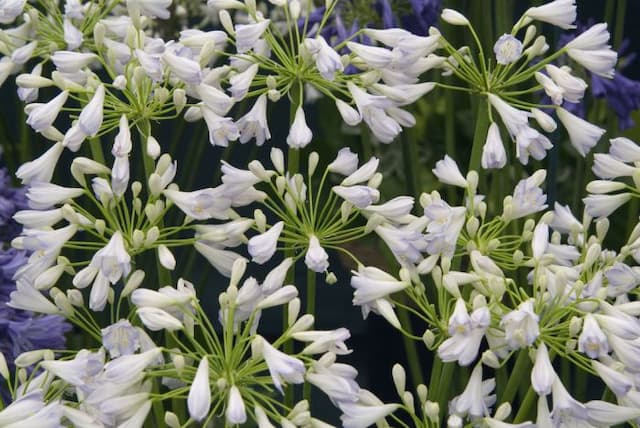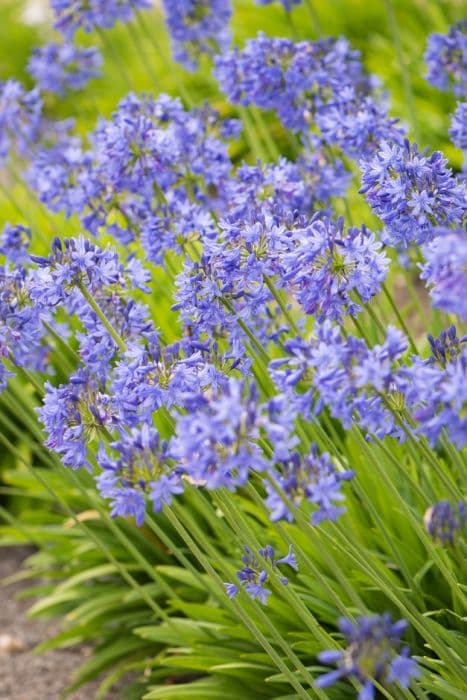African Lily Agapanthus 'Castle of Mey'

ABOUT
The Castle of Mey Agapanthus, commonly referred to as the African Lily, is recognized for its striking floral display and arching foliage. It manifests a lush clump of strap-shaped leaves that are a deep, glossy green, creating a vibrant backdrop for its blooms. During its flowering season, it produces tall and sturdy stems, atop which rest rounded clusters of funnel-shaped flowers. These blossoms are a captivating blue or purple, often with a paler or darker stripe running down the middle of each petal, which adds a dramatic contrast to the green leaves. The flowers are neatly arranged in a spherical umbel and can resemble fireworks when in full bloom. The buds are equally ornamental, starting off in a tighter cluster before progressively opening into the characteristic umbrella-like form. The Castle of Mey is a beautiful and resilient variety of Agapanthus that puts on a splendid show, and can often attract pollinators such as bees and butterflies.
About this plant
 Names
NamesFamily
Amaryllidaceae
Synonyms
Lily of the Nile, African Lily
Common names
Agapanthus 'Castle of Mey'
 Toxicity
ToxicityTo humans
The Agapanthus, commonly known as the Lily of the Nile, is not highly toxic to humans, but it can cause mild stomach upset if ingested. The plant contains substances such as saponins, which can cause nausea, vomiting, and diarrhea if consumed in large quantities. Skin contact with the sap may lead to irritation or an allergic reaction in some individuals. It is generally recommended to avoid consuming any part of the plant.
To pets
The Lily of the Nile, while not extremely toxic, can be harmful to pets if ingested. The plant's components, including saponins, may induce symptoms such as vomiting, diarrhea, nausea, and even salivation. It is advised to keep pets away from the plant and to seek veterinary attention if they consume any part of it.
 Characteristics
CharacteristicsLife cycle
Perennials
Foliage type
Evergreen
Color of leaves
Green
Flower color
Blue
Height
2 feet (60 cm)
Spread
2 feet (60 cm)
Plant type
Bulb
Hardiness zones
8
Native area
South Africa
Benefits
 General Benefits
General Benefits- Ornamental Appeal: Agapanthus 'Castle of Mey' is known for its striking blue-violet flowers that add a splash of color to gardens.
- Drought Tolerance: Once established, this Lily of the Nile variety is quite drought-tolerant, requiring minimal watering.
- Low Maintenance: It is generally easy to care for, with limited pruning and feeding needed.
- Attracts Wildlife: The vibrant blooms attract pollinators such as bees and butterflies, enhancing biodiversity.
- Rabbit Resistant: Its foliage and flowers are not a favorite of rabbits, minimizing damage from wildlife.
- Tolerant of Soil Types: Agapanthus can adapt to a variety of soil conditions, though it prefers well-draining soil.
- Container Gardening: Suitable for pots and containers, it offers flexibility for those with limited space.
- Long Blooming Period: The long-lasting flowers provide aesthetic appeal throughout the summer months.
- Coastal Resilience: This plant is salt-tolerant and can thrive in coastal environments.
- Border Planting: It is commonly used in borders and beds, adding structure and color contrasts to garden designs.
- Cut Flowers: The blooms are suitable for cut flower arrangements, bringing beauty indoors.
 Medical Properties
Medical PropertiesThis plant is not used for medical purposes.
 Air-purifying Qualities
Air-purifying QualitiesThis plant is not specifically known for air purifying qualities.
 Other Uses
Other Uses- Decorative Borders: Agapanthus, with its lush foliage and striking flowers, can be used to create eye-catching decorative borders along walkways or garden edges.
- Floral Arrangements: The long-stemmed blooms of Agapanthus make them ideal for inclusion in fresh floral arrangements and bouquets.
- Color Accent in Landscaping: The vibrant blue or purple flowers of Agapanthus can provide a beautiful color accent in predominantly green landscapes.
- Theme Gardens: Agapanthus can be included in a "blue-themed" garden alongside other plants that flower in various shades of blue.
- Erosion Control: The dense root system of Agapanthus can help stabilize slopes and areas prone to erosion.
- Poolside Planting: Agapanthus can tolerate some splashing and can be planted around pools for a lush, tropical effect.
- Focal Point Creation: Due to its dramatic blooms, Agapanthus can be used as a focal point plant in a garden or yard.
- Container Gardening: Agapanthus is well-suited for container gardening on patios, balconies, or decks where ground space is limited.
- Pond or Water Feature Surrounds: Agapanthus can be planted around ponds or water features for a naturalized look.
- Garden Dividers: The height and clumping nature of Agapanthus make it a good choice for dividing different sections of a garden without constructing physical barriers.
Interesting Facts
 Feng Shui
Feng ShuiThe African Lily is not used in Feng Shui practice.
 Zodiac Sign Compitability
Zodiac Sign CompitabilityThe African Lily is not used in astrology practice.
 Plant Symbolism
Plant Symbolism- Love Letters: The name Agapanthus comes from the Greek words 'agape' meaning love, and 'anthos' meaning flower, symbolizing love and adoration.
- Beauty: With its striking blue to purple flowers, the Agapanthus is often associated with beauty and elegance.
- Strength and Resilience: Agapanthus plants are known for their hardiness and ability to withstand tough conditions, representing strength and resilience.
- Fertility and Prosperity: The lush and full blossoms of the Agapanthus can symbolize fertility and the hope for prosperity.
- Solitude or Loneliness: Sometimes referred to as the "flower of love," when given in the singular number, it can symbolize solitude or a feeling of being forgotten.
 Water
WaterAgapanthus, commonly known as Lily of the Nile, should be watered deeply when the top inch of soil feels dry, which typically amounts to watering once a week during active growth in the spring and summer. The amount of water needed will vary based on the size of the plant and environmental conditions, but as a general guideline, use about 1 to 1.5 gallons per watering session for a medium-sized plant. During the dormant period in fall and winter, reduce watering frequency to every two to three weeks, making sure not to let the soil become completely dry for prolonged periods. Adjust watering based on rainfall, lessening the amount if natural precipitation is providing moisture.
 Light
LightLily of the Nile thrives in full sunlight to partial shade, making it versatile for different garden spots. The ideal location provides at least 6 hours of direct sunlight each day, which helps to ensure healthy growth and abundant flowering. If grown indoors, a south-facing window is a suitable spot, as it provides ample bright light. Avoid deep shade as this will reduce blooming and can lead to leggy, weak growth.
 Temperature
TemperatureLily of the Nile prefers temperatures ranging from 50 to 80 degrees Fahrenheit. It can survive minimum temperatures down to about 25 degrees Fahrenheit but should be protected from frost, which can cause damage to the foliage and roots. For optimal growth, maintain a temperate climate with moderate warmth, avoiding extreme heat above 90 degrees Fahrenheit, which may cause stress to the plant.
 Pruning
PruningPrune Lily of the Nile after it has finished flowering, typically late summer or early fall, to keep the plant tidy and encourage new growth. Deadhead spent blooms by cutting back the flower stalks to the base to prevent the plant from expending energy on seed production. Every 3 to 4 years, in early spring, divide and cut back the foliage to rejuvenate the plant and promote vigorous growth. The best time for major pruning is when plants are not in bloom to avoid cutting away potential flowers.
 Cleaning
CleaningAs needed
 Soil
SoilLily of the Nile, or Agapanthus 'Castle of Mey', thrives best in a soil mix that is well-draining and fertile, with a pH between 6.0 and 8.0. A blend of two parts loam, one part perlite or sand, and one part compost or well-rotted manure will create an optimal growing medium for this plant.
 Repotting
RepottingLily of the Nile should be repotted every 2 to 3 years to ensure it has enough room to grow. The best time to repot is in the spring before it enters its active growing phase. However, since they bloom better when slightly root bound, make sure not to repot too frequently.
 Humidity & Misting
Humidity & MistingLily of the Nile prefers moderate humidity levels but is quite adaptable and can tolerate the humidity levels found in most homes. There is no need for additional humidity adjustments for this plant when grown indoors.
 Suitable locations
Suitable locationsIndoor
Place in bright, indirect light and water when top inch of soil is dry.
Outdoor
Full sun to partial shade; protect from harsh midday sun.
Hardiness zone
8-11 USDA
 Life cycle
Life cycleThe 'Castle of Mey' Agapanthus, commonly known as African Lily, begins its life cycle when seeds germinate, typically requiring a warm temperature and moist soil conditions. As seedlings establish, they develop fleshy roots and strap-like leaves, forming a foliage clump. Over a few years, the plant matures and begins producing tall flower stalks, each topped with a spherical cluster of trumpet-shaped flowers, usually in shades of blue or purple, blooming through summer. After the flowering period, seeds are produced in pods that eventually dry and open to release the seeds, completing the reproductive cycle. The African Lily may also be propagated vegetatively through division of the clump, allowing for quicker maturity compared to seed-grown plants. With proper care, Agapanthus 'Castle of Mey' can live many years, dying back to the ground in winter to emerge again in spring in regions with colder climates or remaining evergreen in milder areas.
 Propogation
PropogationPropogation time
Spring-Early Summer
Propogation: The Agapanthus 'Castle of Mey', commonly known as the African Lily, is most effectively propagated through division. This process is typically carried out in the spring, before the growing season begins. To propagate the African Lily by division, carefully lift the plant from the ground and gently separate the root cluster into smaller sections, each with a portion of the root system and several shoots attached. These sections can then be directly planted into well-draining soil, ensuring that the crowns of the divisions are just above the soil surface. Water the newly planted divisions adequately to help them establish. It is important to provide regular watering until the plant is well-rooted, but always avoid overwatering which can lead to root rot.









![African lily [Brilliant Blue]](/_next/image?url=https%3A%2F%2Fplants-admin.emdemapps.com%2Fimages%2Fplants%2F%2Fimages%2F604b5e3c28e2b.png&w=640&q=75)